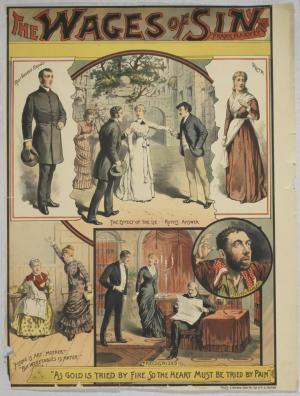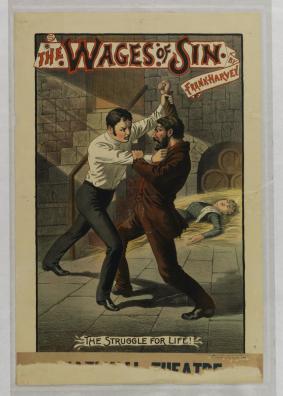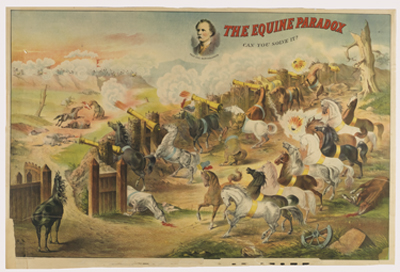If an event takes place, but leaves no evidence of having occurred, did it really happen? Recently, I found myself pondering this historical variation on the age-old question “If a tree falls in a forest, does it make a sound?” when I digitized several items from HSP’s collection of Theater Posters [V06]. As historians and archivists, our understanding of the past is so dependent upon the evidence left behind and some events are so ephemeral they are simply lost to the passage of time. And in the days before television and the Internet, popular culture could be especially ephemeral, leaving only the faintest trace of the traveling minstrel show or transient circuses that captivated the lucky spectators. Thankfully, in the case of HSP’s Theater Posters collection, hundreds of plays, wild west shows, operas, burlesques, musical reviews, and other amusements endure and provide a lively and colorful window into nineteenth-century entertainment.
The Theater Posters collection at HSP contains over 1,300 theatrical posters and announcements for performances and shows of various kinds, many of which were performed in Philadelphia theaters. Often laden with imagery and dramatic action, these posters are a great visual resource and compel you learn more about the sights and scenes depicted. Fortunately, in the case of two recently digitized items, I was able to do just that, as I dug into the history of Frank Harvey’s play “The Wages of Sin” and Professor George Bartholomew’s horse spectacle “Equine Paradox!”
 When I first laid eyes on the posters for “The Wages of Sin,” I was immediately taken by their visual melodrama, an effect matched by equally melodramatic captions like “The Struggle for Life!” and "As Gold is Tried by Fire, So the Heart Must be Tried by Pain." A quick web search yielded several contemporary newspaper accounts of the play in sources as varied as The New York Times and The Brisbane Courier; from these accounts, I discerned that “The Wages of Sin” dates to the 1880s and is essentially a morality tale about the effects of a lie and the penalty for sin.
When I first laid eyes on the posters for “The Wages of Sin,” I was immediately taken by their visual melodrama, an effect matched by equally melodramatic captions like “The Struggle for Life!” and "As Gold is Tried by Fire, So the Heart Must be Tried by Pain." A quick web search yielded several contemporary newspaper accounts of the play in sources as varied as The New York Times and The Brisbane Courier; from these accounts, I discerned that “The Wages of Sin” dates to the 1880s and is essentially a morality tale about the effects of a lie and the penalty for sin.
As depicted on the three posters in HSP's collection, "The Wages of Sin" tells the story of Ruth, a young orphan woman who rejects her suitor, the Reverend George Brand, after a false report casts aspersions on his character. Ruth then marries Harry Wentworth, a true ne’er-do-well who proves to be a drunken, lazy brute and drives Ruth to a life of starvation and crime. At the center of the action is Stephen Mailer, a factory clerk who is the source of the false rumor about George and whose dishelved visage effectively casts him as a villian. And while my research didn't yield too many clues about the play's ultimate denouement, one poster suggests a life-and-death struggle between George and Stephen while Ruth lies helplessly in the background. Praised in The New York Times as a "vigorous and successful melodrama," "The Wages of Sin" played to audiences in England, the United States, and Australia throughout the 1880s and was performed in Philadelphia at the Olympic Theater in the summer of 1883.
and drives Ruth to a life of starvation and crime. At the center of the action is Stephen Mailer, a factory clerk who is the source of the false rumor about George and whose dishelved visage effectively casts him as a villian. And while my research didn't yield too many clues about the play's ultimate denouement, one poster suggests a life-and-death struggle between George and Stephen while Ruth lies helplessly in the background. Praised in The New York Times as a "vigorous and successful melodrama," "The Wages of Sin" played to audiences in England, the United States, and Australia throughout the 1880s and was performed in Philadelphia at the Olympic Theater in the summer of 1883.
If "The Wages of Sin" captured my imagination with the dramatic illustrations on its posters, the traveling horse extravaganza "Equine Paradox!" truly intrigued and perplexed me. Captioned "The Horse Past, Present, and Future," the posters for "Equine Paradox!" portray horses in various scenes and eras of history, from the sands of ancient Egypt to the horse-and-buggies of the nineteenth century. Most striking are the depictions of horses performing various human tasks, such as reading and using the telephone. Thankfully, to help decipher these strange images, I found a short pamphlet in HSP's printed materials promoting a two-week engagement of "Equine Paradox!" at the Arch Street Opera House in December 1884.
 Advertised as "refined, interesting, amusing, and instructive," "Equine Paradox!" was the work of Professor George Bartholomew, a native of upstate New York who, after seeking his fortune in the California gold rush, subsequently developed a so-called "school for horses." A traveling exhibition, "Equine Paradox!" purported to demonstrate the results of Prof. Bartholomew's efforts to instill horses with the ability to understand their master and willingly obey his commands. With a cast of "twenty educated horses" who "do everything but talk," the show featured horses performing feats of "progressive intelligence," such a communicating with bells and using a see-saw to illustrate cause-and-effect. According to the pamphlet produced for the 1884 Philadelphia engagement, "Equine Paradox!" had played over 100 shows and was on its "farewell tour," as Prof. Bartholomew planned to retire from public life.
Advertised as "refined, interesting, amusing, and instructive," "Equine Paradox!" was the work of Professor George Bartholomew, a native of upstate New York who, after seeking his fortune in the California gold rush, subsequently developed a so-called "school for horses." A traveling exhibition, "Equine Paradox!" purported to demonstrate the results of Prof. Bartholomew's efforts to instill horses with the ability to understand their master and willingly obey his commands. With a cast of "twenty educated horses" who "do everything but talk," the show featured horses performing feats of "progressive intelligence," such a communicating with bells and using a see-saw to illustrate cause-and-effect. According to the pamphlet produced for the 1884 Philadelphia engagement, "Equine Paradox!" had played over 100 shows and was on its "farewell tour," as Prof. Bartholomew planned to retire from public life.
Interestingly, while Prof. Bartholomew denied that Darwin's theory of evolution influenced his efforts, the idea that, through conditioning and environmental circumstances, horses could be educated like children is undeniably tinged with the Darwinism of the age. And just as "Equine Paradox!" highlights the debates and conventions of its time, the instructive melodrama of "The Wages of Sin" equally captures the morality and concerns of its era. As evidence of these productions and the ages they embody, HSP's Theater Posters are an important historical, as well as visual, resource and provide an entertaining link to another time and place. Check out the Digital Library for more images from the Theater Posters collection or search our online catalog for a full listing of HSP's holdings. 

